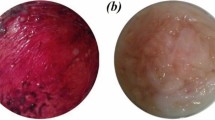Abstract
The subretinal transplantation of retinal pigment epithelial cells (RPE cells) grown on polymeric supports may have interest in retinal diseases affecting RPE cells. In this study, montmorillonite based polyurethane nanocomposite (PU-NC) was investigated as substrate for human RPE cell growth (ARPE-19 cells). The ARPE-19 cells were seeded on the PU-NC, and cell viability, proliferation and differentiation were investigated. The results indicated that ARPE-19 cells attached, proliferated onto the PU-NC, and expressed occludin. The in vivo ocular biocompatibility of the PU-NC was assessed by using the HET-CAM; and through its implantation under the retina. The direct application of the nanocomposite onto the CAM did not compromise the vascular tissue in the CAM surface, suggesting no ocular irritancy of the PU-NC film. The nanocomposite did not elicit any inflammatory response when implanted into the eye of rats. The PU-NC may have potential application as a substrate for RPE cell transplantation.




Similar content being viewed by others
References
Srivastava GK. Elastin-like recombinamers as substrates for retinal pigment epithelial cell growth. J Biomed Mater Res Part A. 2011;97A:243.
Klein R. The epidemiology of age related macular degeneration. Am J Ophthalmol. 2004;137:486–95.
Veritti D. Neovascular age-related macular degeneration. Ophthalmologica. 2012;227(suppl 1):11.
Lu JT. Thin collagen film scaffolds for retinal epithelial cell culture. Biomaterials. 2007;28(8):1486–94.
Lu B. Mesh-supported submicron parylene-C membranes for culturing retinal pigment epithelial cells. Biomed Microdevices. 2012;. doi:10.1007/s10544-012-9645-8.
Zarbin MA. Current concepts in the pathogenesis of age-related macular degeneration. Arch Ophthalmol. 2004;122:598–614.
Tezel TH. Adult retinal pigment epithelial transplantation in exudative age-related macular degeneration. Am J Ophthalmol. 2007;143:584–5.
Pieramici DJ. Occult with no classic subfoveal choroidal neovascular lesions in age-related macular degeneration: clinically relevant natural history information in larger lesions with good vision from the Veteporfin in photodynamic therapy (VIP) Trial: VIP report no. 4. Arch Ophthalmol. 2006;124:660–4.
Stevenson MR. Visual functioning and quality of life in the subfoveal radiotherapy study (SFRADS): SFRADS report no. 2. Br J Ophthalmol. 2005;89:1045–51.
Mruthyunjaya P. Impact of fluorescein angiographic characteristics of macular lesions on outcomes after macular translocation 360 degrees surgery in eyes with age-related macular degeneration. Retina. 2005;25:597–607.
Binder S. Transplantation of autologous retinal pigment epithelium in eyes with foveal neovascularization resulting from age-related macular degeneration: a pilot study. Am J Ophthalmol. 2002;133:215–25.
Abe T. Autologous iris pigment epithelial cell transplantation in monkey subretinal region. Curr Eye Res. 2000;20:268–75.
Wongpichedchai S. Comparison of external and internal approaches for transplantation of autologous retinal pigment epithelium. Invest Ophthalmol Vis Sci. 1992;33:3341–2.
Lane C. Transplantation of retinal pigment epithelium using a pars plana approach. Eye. 1989;3:27–32.
Hynes SR. A tissue-engineered approach towards retinal repair: scaffolds for cell transplantation to the subretinal space. Graefes Arch Clin Exp Ophthalmol. 2010;248(6):763–8.
Da Silva GR. Polyurethanes as supports for human retinal pigment epithelium cell growth. Int J Artif Organs. 2011;34(2):198–9.
Binder S. Transplantation of RPE in AMD. Prog Retin Eye Res. 2007;26:516–54.
Fitzpatrick SD. PNIPAAm-grafted-collagen as an injectable, in situ gelling, bioactive cell delivery scaffold. Biomacromolecules. 2010;11:2261–7.
McUsic AC. Guiding the morphogenesis of dissociated newborn mouse retinal cells and hES cell-derived retinal cells by soft lithography-patterned microchannel PLGA scaffolds. Biomaterials. 2012;33:1396–405.
Thomson HAJ. Optimisation of polymer scaffolds for retinal pigment epithelium (RPE) cell transplantation. Br J Ophthalmol. 2011;95:563–8.
Krishna Y. Polydimethylsiloxane as a substrate for retinal pigment epithelial cell growth. J Biomed Mater Res A. 2007;80(3):669–78.
Williams RL. Polyurethanes as potential substrates for sub-retinal retinal pigment epithelial cell transplantation. J Mater Sci Mater Med. 2005;16:1087–92.
Pinto FCH. Montmorillonite clay-based polyurethane nanocomposite as local triamcinolone acetonide delivery system. J Nanomaterials. 2011;. doi:10.1155/2011/528628.
Da Silva GR. Biodegradation of polyurethanes and nanocomposites to non-cytotoxic degradation products. Polym Degrad Stab. 2010;95:491–9.
Da Silva GR. Controlled release of dexamethasone acetate from biodegradable and biocompatible polyurethane and polyurethane nanocomposite. J Drug Target. 2009;17(5):374–83.
Silva GR. Biodegradable polyurethane nanocomposites containing dexamethasone for ocular route. Mater Sci Eng C. 2011;31:414–22.
Gupta H. Sparfloxacin-loaded PLGA nanoparticles for sustained ocular drug delivery. Nanomedicine. 2010;6:324–33.
Korte GE. Reorganization of actin microfilaments and microtubules in regenerating retinal pigment epithelium. Exp Eye Res. 1995;61:189–203.
Ramakrishna S. Biomedical applications of polymer-composite materials: a review. Comp Sci Technol. 2001;61(9):1189–94.
Ratner B, Hoffman A, Schoen F, Lemons J. An introduction to materials in medicine. Biomaterials Science: Academic Press; 1996.
Thomson RC. Manufacture and characterization of poly(α-hydroxy ester) thin films as temporary substrates for retinal pigment epithelium cells. Biomaterials. 1996;17:321–7.
Burke JM. Phenotypic heterogeneity of retinal pigment epithelial cells in vitro and in situ. Exp Eye Res. 1996;62:63–73.
Zarbin MA. Analysis of retinal pigment epithelium integrin expression and adhesion to aged submacular human Bruch’s membrane. Trans Am Ophthalmol Soc. 2003;101:499.
Lund RD. Retinal transplantation: progress and problems in clinical application. J Leukoc Biol. 2003;74:151.
Kearns V. Plasma polymer coatings to aid retinal pigment epithelial growth for transplantation in the treatment of age related macular degeneration. J Mater Sci Mater Med. 2012;. doi:10.1007/s10856-012-4675-6.
Alge CS. Differential protein profiling of primary versus immortalized human RPE cells identifies expression patterns associated with cytoskeletal remodeling and cell survival. J Proteome Res. 2006;5:862–8.
Gullapalli VK. Culture-induced increase in alpha integrin subunit expression in retinal pigment epithelium is important for improved resurfacing of aged human Bruch’s membrane. Exp Eye Res. 2008;86:189.
Acknowledgments
The authors would like to acknowledge financial support from the following institutions: CAPES/MEC (Brazil), CNPq/MCT (Brazil) and FAPEMIG (Minas Gerais—Brazil).
Author information
Authors and Affiliations
Corresponding author
Rights and permissions
About this article
Cite this article
Da Silva, G.R., Da Silva-Cunha, A., Vieira, L.C. et al. Montmorillonite clay based polyurethane nanocomposite as substrate for retinal pigment epithelial cell growth. J Mater Sci: Mater Med 24, 1309–1317 (2013). https://doi.org/10.1007/s10856-013-4885-6
Received:
Accepted:
Published:
Issue Date:
DOI: https://doi.org/10.1007/s10856-013-4885-6




